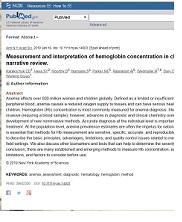Anemia affects over 800 million women and children globally. Defined as a limited or insufficient functional red blood cell supply in peripheral blood, anemia causes a reduced oxygen supply to tissues and can have serious health consequences for women and children. Hemoglobin (Hb) concentration is most commonly measured for anemia diagnosis. Methods to measure Hb are usually invasive (requiring a blood sample); however, advances in diagnostic and clinical chemistry over the past decade have led to the development of new noninvasive methods. Accurate diagnosis at the individual level is important to identify individuals who require treatment. At the population level, anemia prevalence estimates are often the impetus for national nutrition policies or programs. Thus, it is essential that methods for Hb measurement are sensitive, specific, accurate, and reproducible. The objective of this review is to describe the basic principles, advantages, limitations, and quality control issues related to methods of Hb measurement in clinical and field settings. There is also discussion of other biomarkers and tests that can help to determine the severity and underlying causes of anemia.
It was found that there are many established and emerging methods to measure Hb concentration, each with their own advantages, limitations, and factors to consider before use.
Authors: CD Karakochuk, SY Hess, D Moorthy, S Namaste, ME Parker, AI Rappaport, R Wegmuller, O Dary
Abstract only


